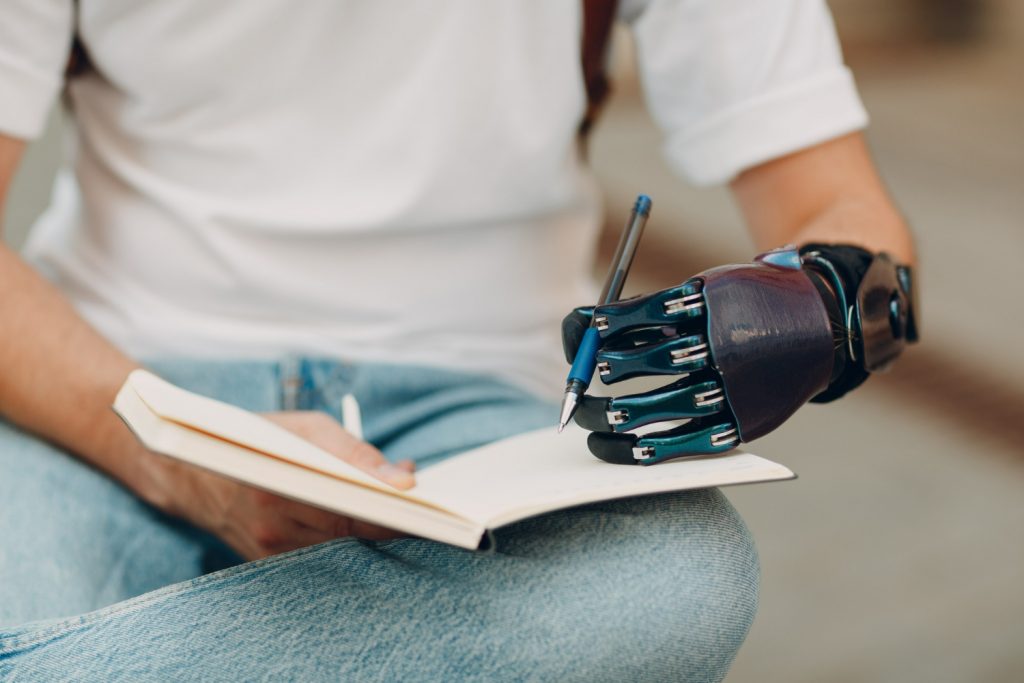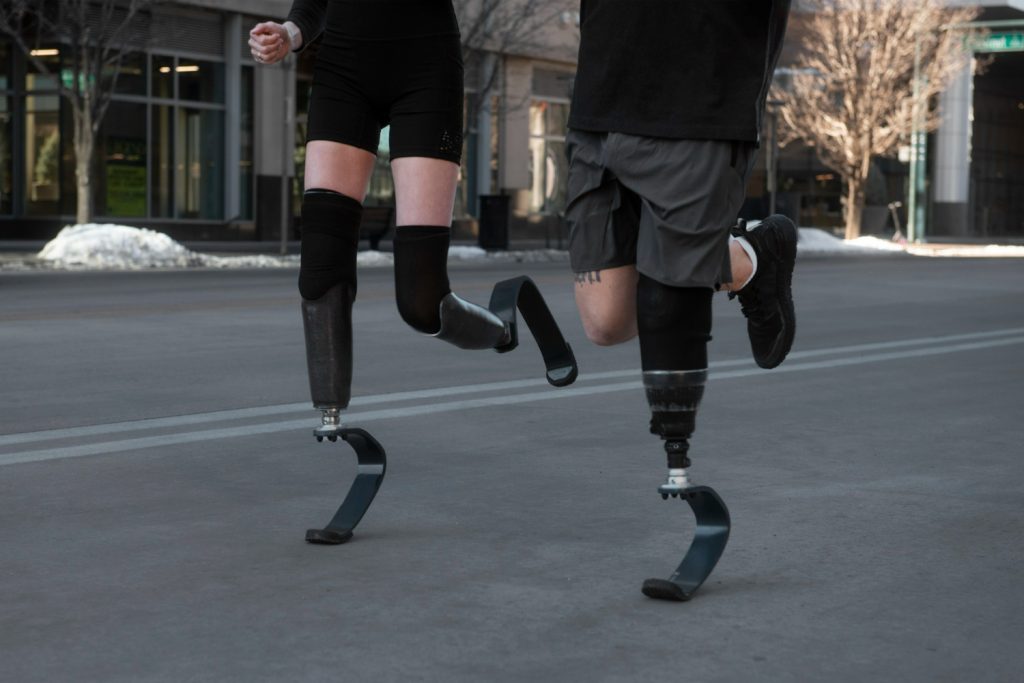Design and craft prosthetics
Design and lettering of prosthetics
Exploring the past, present, and future of design and artificial intelligence, this art features stories of professional athletes, veterans, children, and other users who have collaborated with prosthetists and designers to create prosthetics with improved functionality, comfort, adaptability, and aesthetics.


As a prosthetic wearer, you certainly want to be confident that your joint meets your daily demands and supports your variable speeds of movement and different walking styles. Through continuous development, Tadawi Center aims to provide the appropriate joint that makes you as independent as possible in daily life, in cooperation with the best international companies that manufacture proteor prosthetics.
To achieve this goal, the Tadawi Center, with its medical expertise, strives to manufacture high-quality orthopedic devices and prosthetics. Our goal is to promote vitality and successful rehabilitation for all assigned patients.
Our vision is to create a new and productive future for those who are motivated to overcome their disability. We honor the great dream of all amputees and people of determination to achieve growth at all levels for themselves. Because we believe that “hope begins with a prosthetic limb.”
Prosthetic limb
It is a manufactured extension that replaces a missing body part. Prosthetics are divided into two main groups: upper limbs and lower limbs.
When talking about prosthetics, it is important to note the differences between the numerous types and their uses: we are here to explain what these prosthetic devices do and how they work.
Intelligent electronic prosthetics
Myoelectric control of the prosthesis is exactly what an electronic prosthetic looks like. But how do these electronic prosthetics work?
Simply put, these prosthetics are externally powered (by batteries) and controlled by electronic signals generated by the user's muscles. Thanks to smart technology, the accuracy with which these signals are interpreted is growing rapidly.
When talking about prosthetics, it is important to note the differences between the various types and their uses: we are here to explain what these prosthetic devices do and how they work.
Intelligent electronic prosthetics
Myoelectric control of the prosthesis is exactly what an electronic prosthetic looks like. But how do these electronic prosthetics work?
Simply put, these prosthetics are externally powered (by batteries) and controlled by electronic signals generated by the user's muscles. Thanks to smart technology, the accuracy with which these signals are interpreted is growing rapidly.
Hydraulic prosthetics
These limbs are formed by adding a pneumatic or hydraulic component (piston inside cylinders containing air or fluid) to a uniaxial or multiaxial knee. These components control the oscillating motion of the prosthetic knee and allow the individual to change speeds.
Hydraulic prosthetics
These limbs are formed by adding a pneumatic or hydraulic component (piston inside cylinders containing air or fluid) to a uniaxial or multiaxial knee. These components control the oscillating motion of the prosthetic knee and allow the individual to change speeds.
Cosmetic prosthetics, also known as custom silicone restorations.
Custom cosmetic prosthetics are manufactured from a clear silicone glove designed to fit in high detail to the unaffected hand and can include wrinkles, veins, joint definition, and nails. The clear silicone is then painted by an artist to perfectly match the individual's current skin tone, body hair, freckles and other natural features. Tattoos and other unique artwork can also be included for greater individual expression
Cosmetic prosthetics, also known as custom silicone restorations.
Custom cosmetic prosthetics are manufactured from a clear silicone glove designed to fit in high detail to the unaffected hand and can include wrinkles, veins, joint definition, and nails. The clear silicone is then painted by an artist to perfectly match the individual's current skin tone, body hair, freckles and other natural features. Tattoos and other unique artwork can also be included for greater individual expression
What amputees should know about prosthetic legs
Learning how to use a prosthetic leg is a good way to start. The prosthetic legs are made of durable, lightweight and long-lasting materials. Your residual limb fits into the prosthetic socket because the socket is a mold of your residual limb. The prosthetic leg or prosthetic arm is connected to the body with different systems. Some of these systems are different options such as vacuum system, remote lock, and silicone liner suspension system. Designing and manufacturing prosthetics is both an art and a science and requires an understanding of physics, engineering, anatomy, and physiology. The prosthetist begins by taking a plaster cast of the residual limb. This template helps create the correct size of prosthetic leg/prosthetic arm to see which option is best for you. The mold, which is called the socket, is the most important part of the prosthetic limb because it connects the body to the rest of the limb’s components, transfers the body’s weight, and distributes pressure and load on the amputated part in a comfortable and safe manner. A comfortable and appropriate socket is the standard in the quality of the prosthetic limb, so the center and specialists with sufficient experience must be chosen, and this is what the Tadawi Center provides in terms of quality, experience and trust.
Rehabilitation of the prosthesis plays a big role
After making your choice regarding the prosthesis, you should definitely work with a physical therapist, as well as personal production and full compliance with the prosthesis. Physical therapy assistance is very important in determining your road map for the process of adapting to the prosthesis, reactivating and strengthening your muscles
Tadawi Center’s physical therapists will help you make walking with the prosthesis easier during rehabilitation, explain how to insert and remove the prosthesis, etc.
Plus, your arms, legs, and core will get stronger with exercise. Our physical therapists, occupational therapists, prosthetists, and doctors will help you create a personalized plan to work toward your movement goals. It is important to have a team of healthcare professionals to support you during the recovery process from the loss of a limb. You can make an appointment from the Tadawi Center for Prosthetics and Orthotics to get a plan that is beneficial to you
Engineer Haya Kerman
Please contact us and get more information about the design and craftsmanship of prosthetics.
